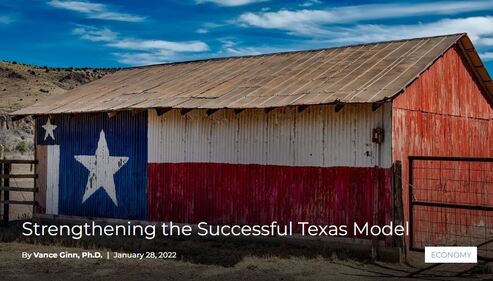 Texas continues to recover from the shutdown recession of 2020. The state has made strong progress toward a full recovery, especially compared to other states. But it has much room for improvement by many metrics before we’ll see the robust pre-shutdown prosperity. In February 2020, Texas had low unemployment and relatively high labor force participation. The unemployment rate was just 3.7%, which some economists consider to be full employment. That basically means the state’s labor resources were being used as efficiently as possible and there was no cyclical unemployment, which occurs when the economy is in recession or growing too slowly. Likewise, a large portion of the population was participating in the labor market. In February 2020, the labor force participation rate was 64% and the employment-to-population ratio was 61.6%. That then changed drastically with the COVID-19 pandemic and government-imposed shutdowns in March 2020. By April 2020, those numbers had dropped to 60.2% and 52.4%, respectively, the private sector lost 1.4 million jobs (12.8% decline), and the unemployment rate skyrocketed to 12.9%. Since then, Texas has regained its lost private sector jobs, plus another 105,200 jobs, and the unemployment rate is back down to 5%. These data tell an important story about the effect this had on Texans. The best path to prosperity is a job, as work brings dignity and hope to people by allowing them to earn a living, gain skills, and build social capital that endures. Public policy that affects the labor market is so important because it affects people’s livelihoods and their sense of dignity. Last year, the federal government gave extra unemployment payments on top of normal payments. Together, these payments often resulted in recipients receiving more money than they might have made working. This, of course, incentivized them not to work. About half the states, including Texas and mostly red states, rightly ended this program early and those states have been recovering faster than the states which continued the program. The states that discontinued the program before its nationwide expiration in September 2021 have averaged lower unemployment rates. They have also recovered jobs faster, relative to the number of jobs they had before the shutdown recession. Of the 10 states with the highest proportion of private sector employment to pre-pandemic levels, nine are in red states, including Texas. Conversely, six of the 10 states and D.C. with the lowest proportion are in blue places. In general, conservative policies have been more conducive to job growth and overall recovery because they tend to get government out of the way so that people can make the decisions that are best for themselves and their families. Texas is one of just seven states that have recovered all the private sector jobs lost in the shutdown recession. That is an achievement, but the state is still far behind (3% below) the pre-shutdown trend and other measurements of the labor market’s health show that Texas has more work to do. The labor force participation rate is still 1.3 percentage points below its pre-pandemic level, meaning that some people have left the labor market, such as those who have given up looking for work. The employment-to-population ratio is also down 2 percentage points from its pre-pandemic level. It’s important to get these figures back to normal. In November, Texas had 884,000 unfilled job openings and just 770,000 unemployed. That is 114,000 more job openings than workers available to fill them. To fill these jobs, Texas needs more of its people to rejoin the labor market. Achieving that goal starts with responsible government policies. The Texas Model of lower taxes, no personal income tax, less spending, and sensible regulation is necessary to unlock poverty and let people prosper. Texas’ free-market-focused institutions helped the state outpace the national average both in economic growth and income growth in the latest data for the third quarter of 2021. Because the 87th Legislature followed many of the Foundation’s recommendations, especially by passing the strongest spending limit in the nation, these successes for the state and Texans will hopefully continue. But we can do better. Texas can build upon its past success in the upcoming 88th Legislature by further limiting government spending, ensuring opportunities to earn a living, eliminating property taxes, and advancing education freedom. Such efforts will help families flourish, keep Texas Texan, and make Texas the leader for the rest of the nation. https://www.texaspolicy.com/strengthening-the-successful-texas-model/ Comments are closed.
|
Vance Ginn, Ph.D.
|

 RSS Feed
RSS Feed